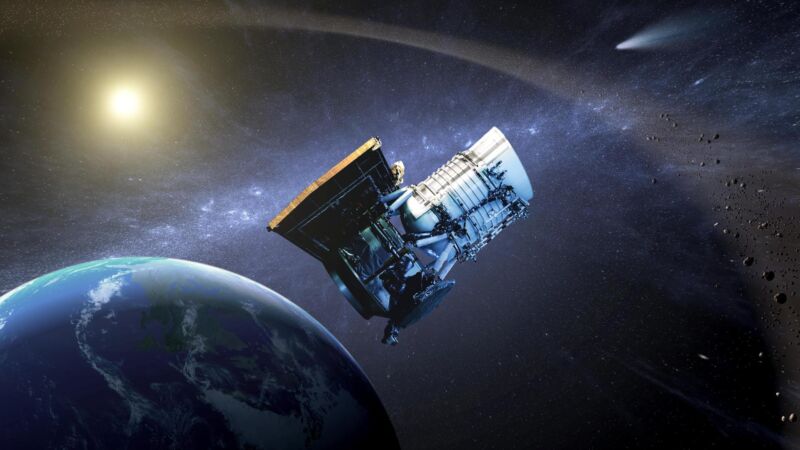
Enlarge / Artist's illustration of NASA's Wide-field Infrared Survey Explorer spacecraft.
Last week, NASA decommissioned a nearly 15-year-old spacecraft that discovered 400 near-Earth asteroids and comets, closing an important chapter in the agency's planetary defense program.
From its position in low-Earth orbit, the spacecraft's infrared telescope scanned the entire sky 23 times and captured millions of images, initially searching for infrared emissions from galaxies, stars, and asteroids before focusing solely on objects within the Solar System.
Wising up to NEOs
The Wide-field Infrared Survey Explorer, or WISE, spacecraft launched in December 2009 on a mission originally designed to last seven months. After WISE completed checkouts and ended its primary all-sky astronomical survey, NASA put the spacecraft into hibernation in 2011 after its supply of frozen hydrogen coolant ran out, reducing the sensitivity of its infrared detectors. But astronomers saw that the telescope could still detect objects closer to Earth, and NASA reactivated the mission in 2013 for another decade of observations.
The reborn mission was known as NEOWISE (Near-Earth Object Wide-field Infrared Survey Explorer). Its purpose was to use the spacecraft's infrared vision to detect faint asteroids and comets on trajectories that bring them close to Earth.
"We never thought it would last this long," said Amy Mainzer, NEOWISE's principal investigator from the University of Arizona and UCLA.
Ground controllers at NASA's Jet Propulsion Laboratory in California sent the final command to the NEOWISE spacecraft on August 8. The spacecraft, currently at an altitude of about 217 miles (350 kilometers), is falling out of orbit as atmospheric drag slows it down. NASA expects the spacecraft will reenter the atmosphere and burn up before the end of this year, a few months earlier than expected, due to higher levels of solar activity, which causes expansion in the upper atmosphere. The satellite doesn't have its own propulsion to boost itself into a higher orbit.
"The Sun's just been incredibly quiet for many years now, but it's picking back up, and it was the right time to let it go," Mainzer told Ars.
Astronomers have used ground-based telescopes to discover most of the near-Earth objects detected so far. But there's an advantage to using a space-based telescope, because Earth's atmosphere absorbs most of the infrared energy coming from faint objects like asteroids.
With ground-based telescopes, astronomers are "predominantly seeing sunlight reflecting off the surfaces of the objects," Mainzer said. NEOWISE measures thermal emissions from the asteroids, giving scientists information about their sizes. "We can actually get pretty good measurements of size with relatively few infrared measurements," she said.
The telescope on NEOWISE was relatively modest in size, with a 16-inch (40-centimeter) primary mirror, more than 16 times smaller than the mirror on the James Webb Space Telescope. But its wide field of view allowed NEOWISE to scour the sky for infrared light sources, making it well-suited for studying large populations of objects. One of the mission's most famous discoveries was a comet officially named C/2020 F3, more commonly known as Comet NEOWISE, which became visible to the naked eye in 2020. As the comet moved closer to Earth, large telescopes like Hubble were able to take a closer look.
“The NEOWISE mission has been an extraordinary success story as it helped us better understand our place in the universe by tracking asteroids and comets that could be hazardous for us on Earth,” said Nicola Fox, associate administrator of NASA's science mission directorate.
What’s out there?
The original mission of WISE and the extended survey of NEOWISE combined to discover 366 near-Earth asteroids and 34 comets, according to the Center for Near-Earth Object Studies. Of these, 64 were classified as potentially hazardous asteroids, meaning they come within 4.65 million miles (7.48 million kilometers) of Earth and are at least 500 feet (140 meters) in diameter. These are the objects astronomers want to find and track in order to predict if they pose a risk of colliding with Earth.
There are roughly 2,400 known potentially hazardous asteroids, but there are more lurking out there. Another advantage of using space-based telescopes to search for these asteroids is that they can observe 24 hours a day, while telescopes on the ground are limited to nighttime surveys. Some hazardous asteroids, such as the house-sized object that exploded in the atmosphere over Chelyabinsk, Russia, in 2013, approach Earth from the direction of the Sun. A space telescope has a better chance of finding these kinds of asteroids.
WISE, and then the extended mission of NEOWISE, helped scientists estimate there are approximately 25,000 near-Earth objects.
"The objects (NEOWISE) did discover tended to be overwhelmingly just dark, [and] these are the objects that are much more likely to be missed by the ground-based telescopes," Mainzer said. "So that, in turn, gives us a much better idea of how many are really out there."